| |
|
Xiamen Oil Paintings, Wholesale Direct!
|
|
100% hand painted, 100% cotton canvas, 100% money back if not satisfaction. |
|
|
|
|
ART WORKS INDEX
A
B
C
D
E
F
G
H
I
J
K
L
M
N
O
P
Q
R
S
T
U
V
W
X
Y
Z
|
|
ARTISTS INDEX
A
B
C
D
E
F
G
H
I
J
K
L
M
N
O
P
Q
R
S
T
U
V
W
X
Y
Z
|
|
|
|
|
|
|
|
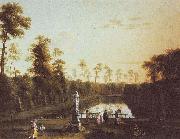 |
Jacob Philipp Hackert
|
|
(September 15, 1737 - April 28, 1807) was a landscape painter from Brandenburg, who did most of his work in Italy.
Hackert was born in 1737 in Prenzlau in the Margraviate of Brandenburg (now in Germany). He trained with his father Philipp (a portraitist and painter of animals) and his uncle, before going to the Akademie der Kenste in Berlin in 1758. Later he traveled to Swedish Pomerania and Stockholm, where he painted murals.
He spent from 1765 to 1768 in Paris, with the Swiss Artist, Balthasar Anton Dunker, where he focused on painting in gouache. He met and was inspired by Claude Joseph Vernet, who was already famous as a painter of landscapes and seascapes, and the German engraver Johann Georg Wille.
In 1768 Hackert left Paris with his brother Georg, and went to Italy, basing himself mainly in Rome and Naples, where he produced many works for Sir William Hamilton. He travelled all over Italy, gaining a reputation as a talented landscape painter.
In 1786 he went to work for Ferdinand I of the Two Sicilies in Naples. He advised on the creation of a painting restoration laboratory at the Museo di Capodimonte, and supervised the transfer of the Farnese collections from Rome to Naples. By this time he had an international reputation, and won commissions from empress Catherine II of Russia, king Louis XVI of France and others. When Goethe visited Naples in 1786, he and Hackert became friends.
|
|
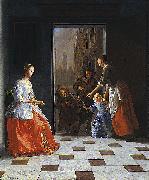 |
Jacob Ochtervelt
|
|
(1634, Rotterdam - 1682, Amsterdam), was a Dutch Golden Age painter.
According to the RKD he was active in Haarlem where he was a student of Nicolaes Pietersz Berchem and later he moved back to Rotterdam (1655-1672) where he was a pupil of Ludolf de Jongh. After the rampjaar he moved to Amsterdam
|
|
 |
Jacob More
|
|
1740-93
Scottish painter, active in Italy. The son of an Edinburgh merchant, he was first apprenticed to a goldsmith and then, from 1766, to the Norie family of house-painters. In the 1760s he produced numerous sketches of the Scottish Lowlands (examples Edinburgh, N.G.), and in 1769 he designed and executed stage sets at the Theatre Royal, Edinburgh, for the first productions after the legalizing of the theatre in Scotland. More's Edinburgh period culminated in a series of oil paintings of the Falls of the River Clyde, three of which are in public collections: Corra Linn (Edinburgh, N.G.), Stonebyres Linn (London, Tate) and Bonnington Linn (Cambridge, Fitzwilliam). These paintings are regarded as the first serious artistic interpretations of the Scottish landscape, depictions by previous artists having been essentially topographical in character. More took a set of three of them to the Society of Artists Exhibition in London in 1771, at which he gained widespread recognition and the personal encouragement of Sir Joshua Reynolds.
|
|
 |
Jacob Maris
|
|
(August 25, 1837, The Hague - August 7, 1899, Karlsbad) was a Dutch painter, who with his brothers Willem and Matthijs belonged to what has come to be known as the Hague School of painters.
Maris studied at the Antwerp Academy, and subsequently in Hubertus van Hove's studio during a stay in Paris from 1865 till 1871. He returned to Holland when the Franco-Prussian War broke out, and died there in August 1899. Though he painted, especially in early life, domestic scenes and interiors invested with deeply sympathetic feeling, it is as a landscape painter that Maris excelled. He was the painter of bridges and windmills, of old quays, massive towers, and level banks; even more was he the painter of water, and misty skies, and chasing clouds. In all his works, whether in water or oil color, and in his etchings, the subject is always subordinate to the effect. His art is suggestive rather than decorative, and his force does not seem to depend on any preconceived method, such as a synthetical treatment of form or gradations of tone. And yet, though his means appear so simple, the artist's mind seems to communicate with the spectator's by directness of pictorial instinct, and we have only to observe the admirable balance of composition and truthful perspective to understand the sure knowledge of his business that underlies such purely impressionist handling.
|
|
 |
Jacob Maentel
|
|
American physician and watercolor portraits painter,1763-1863
|
|
 |
Jacob Levecq
|
|
(1634 - 1675), was a Dutch Golden Age painter trained by Rembrandt.
According to Houbraken, who was his pupil during the last 9 months of his life, he had been trained by Rembrandt, but inherited a sum of money when his parents died, that he used to take care of himself, his two unmarried sisters and a blind half-brother. Houbraken could not recall much of his painting style, since he had been mostly sick while he was living in the house, and he no longer painted actively. In his younger years Levecq travelled to Paris and Sedan where he painted portraits, and on his return to Dordrecht became a portrait painter in the manner of Jan de Baen. When he died, Houbraken inherited a third of his prints, but regretted the fact that as a young boy with little experience in such matters, he only chose prints by Lucas van Leyden and Albert Durer, and had left the French prints for others, and so was very glad that he had received one anyway by Charles le Brun.
|
|
 |
Jacob Koninck
|
|
(c. 1615, Amsterdam - c. 1695, Copenhagen), was a Dutch Golden Age landscape painter.
According to Houbraken he lent his books on perspective to Johannes Verkolje, who became better than he was at perspective drawing.He was a disciple of Adriaen van de Velde who became a popular painter in Copenhagen where he painted for the court of Christian V of Denmark.
According to the RKD he was the uncle of Salomon Koninck, a pupil of David Colijns and became the teacher of his son Jacob II and his younger brother Philips Koninck.He was in Dordrecht from 1633-1636, Rotterdam from 1637-1645, The Hague from 1647-1651, back in Amsterdam in 1658 (when he probably lent young Verkolje his perspective books), and moved to Denmark in 1676.
|
|
 |
Jacob Knyff
|
|
(January 1, 1639, Haarlem - 1681, London), was a Dutch Golden Age painter.
According to Houbraken he was the teacher of Johannes Gottlieb Glauber in Paris in 1671, where he attended the funeral of Nicolaes Berchem II on January 4, 1672. he was probably the son of the painter Wouter Knijff, and is known for painting landscapes and seascapes
|
|
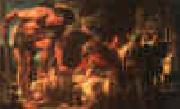 |
Jacob Jordaens
|
|
Flemish Baroque Era Painter, 1593-1678
Jacob Jordeans was born on May 19, 1593, the first of eleven children, to the wealthy linen merchant Jacob Jordaens Sr. and Barbara van Wolschaten in Antwerp. Little is known about Jordaens's early education. It can be assumed that he received the advantages of the education usually provided for children of his social class. This assumption is supported by his clear handwriting, his competence in French and in his knowledge of mythology. Jordaens familiarity with biblical subjects is evident in his many religious paintings, and his personal interaction with the Bible was strengthened by his later conversion from Catholicism to Protestantism. Like Rubens, he studied under Adam van Noort, who was his only teacher. During this time Jordaens lived in Van Noort's house and became very close to the rest of the family. After eight years of training with Van Noort, he enrolled in the Guild of St. Luke as a "waterscilder", or watercolor artist. This medium was often used for preparing tapestry cartoons in the seventeenth century. although examples of his earliest watercolor works are no longer extant. In the same year as his entry into the guild, 1616, he married his teacher's eldest daughter, Anna Catharina van Noort, with whom he had three children. In 1618, Jordaens bought a house in Hoogstraat (the area in Antwerp that he grew up in). He would then later buy the adjoining house to expand his household and workspace in 1639, mimicking Rubens's house built two decades earlier. He lived and worked here until his death in 1678.
Jordaens never made the traditional trip to Italy to study classical and Renaissance art. Despite this, he made many efforts to study prints or works of Italian masters available in northern Europe. For example, Jordaens is known to have studied Titian, Veronese, Caravaggio, and Bassano, either through prints, copies or originals (such as Caravaggio's Madonna of the Rosary). His work, however, betrays local traditions, especially the genre traditions of Pieter Bruegel the Elder, in honestly depicting Flemish life with authenticity and showing common people in the act of celebratory expressions of life. His commissions frequently came from wealthy local Flemish patrons and clergy, although later in his career he worked for courts and governments across Europe. Besides a large output of monumental oil paintings he was a prolific tapestry designer, a career that reflects his early training as a "watercolor" painter.
Jordaens' importance can also be seen by his number of pupils; the Guild of St. Luke records fifteen official pupils from 1621 to 1667, but six others were recorded as pupils in court documents and not the Guild records, so it is probable that he had more students than officially recorded. Among them were his cousin and his son Jacob. Like Rubens and other artists at that time, Jordaens' studio relied on his assistants and pupils in the production of his paintings. Not many of these pupils went on to fame themselves,however a position in Jordaens's studio was highly desirable for young artists from across Europe.
|
|
|
|
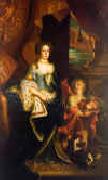 |
Jacob Huysmans
|
|
1633-1696
Flemish
Jacob Huysmans Gallery
Jacob Huysmans (c.1633?C1696), was a Flemish portrait painter. He moved to England during the reign of Charles II where he became one of the fashionable painters of the court. His chief portraits are those of Izaak Walton and Catherine of Braganza, Charles II's wife (both displayed on the National Gallery, London).
He was a pupil of Gilles Backereel and Frans Wouters and came over to England from - presumably - Antwerp. His first works were pastiches of work from Anthony van Dyck. As a Roman Catholic he was favoured by Catharine of Braganza. When Samuel Pepys visited his workshop in Westminster on 26 August 1664, he described him as a 'picture-drawer ... which is said to exceed Lilly (Lely). Huysmans's most important portrait of Catharine of Braganza, Queen Catharine as a Shepherdess (c. 1664; Brit. Royal Col.), was one of the pictures Pepys saw on that occasion. Painting his subjects as sheperdesses with clothing embellished with embroidery and jewellery were typical of his style.
|
|
 |
Jacob Heinrich Elbfas
|
|
Swedish, born circa 1600-1664,was a portrait painter Elbfas was educated in Strasbourg in a tradition drawing back to Renaissance portraits. He established himself in Sweden from 1622 and from 1628 in Stockholm where he became a guild master. During the period 1634-1640 he worked as a court painter for Queen Maria Eleonora. His was frequently employed by the Swedish nobility and his influence on Swedish art was considerable until a new generation of artists were invited by Queen Christina during the 1640s.
|
|
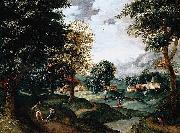 |
Jacob Grimmer
|
|
(ca. 1526-1590) was a Flemish Renaissance landscape painter.
Grimmer was born and died in Antwerp. According to Karel van Mander he first learned to paint landscapes from Matthys Cock and later from Christiaen Queburgh, both of Antwerp. He was a very skilled painter of houses, sky, and foreground views. He was a member of the Guild of St. Luke who was active as a rederijker and acted in many plays.
According to the RKD his earliest dated work is from 1546 and his latest dated work was 1589. Most of his works are landscapes and he worked together with Gillis Mostaert. Abel Grimmer was his son and pupil.
|
|
|
|
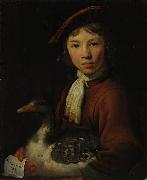 |
Jacob Gerritsz. Cuyp
|
|
was a portrait and landscape painter. He was born and died in Dordrecht, and was the half-brother of Benjamin Gerritsz Cuyp and the father of the much more famous Aelbert Cuyp.
According to Houbraken, he helped the painters Jacques de Claeuw, Isaac van Hasselt, and Cornelis Tegelberg set up a Guild of Saint Luke in Dordrecht in 1642.
|
|
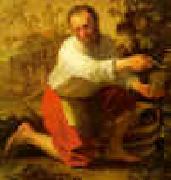 |
Jacob Gerritsz Cuyp
|
|
1594-1652
Dutch
Jacob Gerritsz Cuyp Locations
Painter and draughtsman. Probably taught by his father, he entered the Guild of St Luke in Dordrecht in 1617, the same year that he executed an important commission to portray the masters of the Holland Mint (Dordrecht, Mus. van Gijn). He was the Guild bookkeeper in 1629, 1633, 1637 and 1641 and, according to Houbraken, led Dordrecht fine painters in their separation from the Guild in 1642. Jacob married Aertken van Cooten from Utrecht in 1618; his only child, (3) Aelbert Cuyp, was born two years later.
|
|
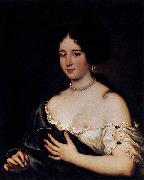 |
Jacob Ferdinand Voet
|
|
(c. 1639 - c. 1689/1700) was a Flemish Baroque portrait painter.
According to the Netherlands Institute for Art History (RKD) he was born at Antwerp as the son of the painter Elias Voet.[1] He travelled to Rome in 1679-1680, Milan in 1680, Florence in 1681, Turin in 1682-1684, and returned to Antwerp in 1684. While in Rome he lived with the painter-engraver Cornelis Bloemaert until he was banned for his portraits of women portrayed with unseemly decollet, whereupon they left Rome together. He undertook a journey to Paris in 1686 where he became court painter until he died there.He is registered as a painter of miniature portraits.
According to Houbraken, he made his return journey to Antwerp from Turin in the company of Jan van Bunnik, who he had already met in Rome in the company of Cornelis Bloemaert. From Turin they set out for Lyons, where they met Adriaen van der Cabel, Peter van Bloemen, and Gillis Wenix. They set off for Paris in the company of a third painter who was a good painter of "bataljes" or battle scenes. Houbraken reports that this was Jacob, Jan van Bunnik's brother, but had not mentioned him earlier in his Jan van Bunnik biography. The RKD makes no mention of a Jacob van Bunnik.
|
|
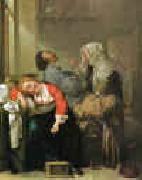 |
Jacob Duck
|
|
1600-1667
Dutch
Jacob Duck Location
Dutch painter and etcher. He was long confused with Jan le Ducq (1629/30-76). In 1621 he was listed as an apprentice portrait painter in the records of the Utrecht Guild of St Luke. His teacher was probably Joost Cornelisz. Droochsloot (1586-1666). The St Job Hospital in Utrecht acquired a Musical Company by him in 1629. By 1630-32 he was a master in the guild. Like Pieter Codde, he painted guardroom scenes (kortegaerdjes), for example Soldiers Arming Themselves (c. 1635; New York, H. Shickman Gal., see 1984 exh. cat., no. 36) or the Hoard of Booty (Paris, Louvre), in which the figures and their interactions are apparently full of underlying symbolic meaning. He also painted merry companies (e.g. c. 1630; Names, Mus. B.-A.) and domestic activities, such as Woman Ironing (Utrecht, Cent. Mus.), employing motifs perhaps symbolic of domestic virtue. He placed his figures in high, bare interiors in which the deep local colours of the foreground stand out well against the cool, greyish-brown background. Only a few of his etchings are known (Hollstein, Dut. & Flem., vi, pp. 9-11), depicting figures in contemporary dress, for example Young Gentleman with Broad Hat and Cloak (Hollstein, no. 10) or Virgin and Child with Magi (nos 1-4). Between 1631 and 1649 Duck presence is documented in Utrecht, Haarlem and Wijk bij Duurstede. Afterwards, and probably by 1656, he was living in The Hague. He was buried at the monastery of St Mary Magdalene in Utrecht.
|
|
 |
Jacob de Wit
|
|
(19 December 1695 - 12 November 1754) was a Dutch artist and interior decorator who painted many religious scenes.
De Wit was born in Amsterdam, and became famous for his door and ceiling paintings. He lived on the Keizersgracht in Amsterdam, and many of the buildings on the Keizersgracht still have door or ceiling paintings done by him. Since many of the families who lived in Amsterdam in those days had country villas, de Wit also painted in houses in the fashionable areas of Haarlem and the Vecht river.
According to the RKD he was the pupil of Albert Spiers in Amsterdam and Jacob van Hal in Antwerp where he became a member of the Guild of St. Luke in 1714. His pupils were Jan de Groot (painter from The Hague), Dionys van Nijmegen, Jan Punt, Pieter Tanje, and the brothers Frans and Jacob Xavery. De Wit died in Amsterdam in 1754.Tako Hajo Jelgersma was his follower.
|
|
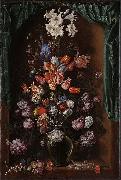 |
Jacob de Gheyn II
|
|
Jacob de Gheyn II (also Jacques de Gheyn II) (c. 1565, Antwerp - March 29, 1629, The Hague) was a Dutch painter and engraver, whose work shows the transition from Northern Mannerism to Dutch realism over the course of his career.
|
|
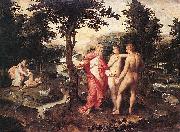 |
Jacob de Backer
|
|
(c. 1555 - c. 1585) was a Flemish Mannerist painter and draughtsman active in Antwerp between about 1571 and 1585.
According to the RKD he was born in Antwerp in c.1540/45 and died there c.1591-1600.De Backer was abandoned by his father as a young boy. Carel van Mander reports that the artist studied with Antonio van Palermo and Hendrik van Steenwijk I, but that Palermo worked him so hard that the young de Backer died in the arms of his master's daughter at the age of thirty.
Although the artist painted in the high mannerist style of Giorgio Vasari, he never appeared to travel to Italy. A series of the "Seven Deadly Sins", however, was bought in Antwerp by Alessandro Farnese's secretary Cosimo Masi in 1594 and taken to Italy.These paintings are now in the Museo di Capodimonte in Naples. Other attributable works include a Last Judgment triptych by him or his studio for Christophe Plantin's tomb in the Antwerp Cathedral (c. 1589; illustrated right), and an Allegory of the Three Ages of Man in the Hermitage Museum, St. Petersburg.
He is not to be confused with the Dutch Golden Age painter Jacob Adriaensz Backer from
|
|
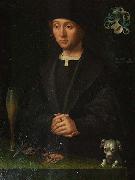 |
Jacob Claesz van Utrecht
|
|
also named by his signature Jacobus Traiectensis (born c. 1479 - dead after 1525) was a Flemish early Renaissance painter who worked in Antwerp and Lebeck.
Jacob van Utrecht's life is still very much in the dark. Research on this important Flemish artist did not start before the end of 19th century. He was probably born in Utrecht, although it is not certain. It is assumed that he became a citizen of Antwerp around 1500 and he is recorded as a "free master craftsman" of the Guild of St Luke there from 1506 to 1512.
From 1519 to 1525 he is recorded as a member of the Leonardsbruderschaft ("Leonard's Brotherhood"), a religious confraternity of merchants in Lebeck among whose ranks the leaders of the Protestant Reformation in the 1530s could be found.
From then on no traces of his life have been found.
|
|
|
|
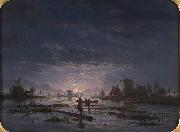 |
Jacob Abels
|
|
(1803 - 1866) was a Dutch painter.
He was born in Amsterdam in 1803, and was instructed in art by Jan van Ravenswaay, the animal painter. In 1826 he visited Germany, and on his return settled at the Hague. He distinguished himself especially in painting moonlight landscapes. The Museum at Haarlem has works by him. Abels died at Abcoude in 1866.
|
|
 |
Jackson Pollock
|
|
l912--1956,U.S. painter. He grew up in California and Arizona. In the early 1930s he studied in New York City under Thomas Hart Benton, and later he was employed on the WPA Federal Art Project. In 1945 he married the artist Lee Krasner. Two years later, after several years of semiabstract work stimulated by psychotherapy, Pollock began to lay his canvas on the floor and pour or drip paint onto it in stages. This process permitted him to record the force and scope of his gestures in trajectories of enamel or aluminum paint that veiled the figurative elements found in his earlier work. The results were huge areas covered with complex and dynamic linear patterns that fuse image and form and engulf the vision of the spectator in their scale and intricacy. Pollock believed that art derived from the unconscious and judged his work and that of others on its inherent authenticity of personal expression. He became known as a leading practitioner of Abstract Expressionism, particularly the form known as action painting. Championed by critic Clement Greenberg and others, he became a celebrity. When he died in a car crash at 44, he was one of the few American painters to be recognized during his lifetime and afterward as the peer of 20th-century European masters of modern art.
|
|
|
|
|
|
|
|
 |
Jacek Malczewski
|
|
(15 July 1854 in Radom - 8 October 1929 in Krakow) was one of the most famous painters of Polish Symbolism. In his creativity he successfully joins the predominant style of his times with motifs of Polish martyrdom.
|
|
|
|
|
|
|
|
|
|
|
|
 |
J.M.W.Turner
|
|
English Romantic Painter, 1775-1851, British land- and seascape artist. Born in London the son of a barber, Turner was precociously talented. He entered the RA Schools in 1789, had a drawing exhibited at the academy in 1790, and was elected a full academician in 1802. He became professor of perspective in 1807. A prolific artist of amazing range of subject and style, he began work in water-colours, quickly founding both a reputation and a fortune, which made him independent of changing public taste. His work was not appreciated by everyone, but his supporters included Thomas Lawrence, John Ruskin, and the earl of Egremont. He died in eccentric obscurity under a false name.
|
|
 |
J.M.W. Turner
|
|
English Romantic Painter, 1775-1851 landscape master
landscape master .British painter and printmaker. He dominated British landscape painting throughout the first half of the 19th century. He established a reputation in the Royal Academy, London, first as a topographical watercolourist and then within a few years as a painter of Sublime and historical landscapes.
|
|
|
|
|
|
|
|
|
|
 |
j. w. wallander
|
|
Jan Wallander är en svensk forskare, författare och företagsledare född 1920. Han är son till arkitekten Sven Wallander. Efter sin doktorsexamen var han verksam som nationalekonom vid Studieförbundet Näringsliv och Samhälle som han var chef för i början av 1950-talet, 1953-1961 var han chef för Industrins Utredningsinstitut. Han bytte bana från forskningen till banksektorn när han anställdes som direktör för Sundsvallsbanken 1961.
|
|
|
|
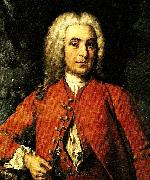 |
j. h. scheffel
|
|
Wismar 1690 - Västerås 1786
J.H. Scheffel kom från en borgasläkt i Wismar, en nordtysk stad som på 1600-talets införlivats med Sverige. Om Scheffels läroår vet man ingenting utöver uppgiften i en gammal biografi att han studerade till målare i Berlin, Paris och Brabant.
Scheffel dök upp i Stockholm år 1723. Uppenbarligen samarbetade han först med David von Krafft. Efter dennes död 1724 grundade Scheffel, då redan fullärd porträttör, sin egen atelj??. Ett av de första uppdragen, porträttet av borgmästare Bergstedts unga dotter, ledde till ett lyckligt och av en riklig hemgift åtföljt äktenskap med fröken Bergstedt.
Scheffel samlade redan tidigt kring sig en trogen kundkrets bland adeln och det förmögna borgarskapet. Han behöll sin framgångsrika position från 1720-talet till 1760-talet. Någon ledande hovmålare eller mest gynnad societetsmålare i Stockholm var Scheffel aldrig. Hans stadiga popularitet som pålitlig och kompetent porträttmålare rubbades emellertid inte av modets växlingar, ty han hade förmågan att smidigt följa de nya strömningarna utan att pruta på sin karga och förnuftiga konstnärliga egenart. Scheffels porträtt visar sällan prov på pretentiösa barockgester eller affekterad romantisk tillgjordhet. Hans personåtergivning var utfunderad och konstaterande. I hans digra produktion ingår stela rutinarbeten, men i bästa fall är hans målningar karaktärsstudier som bygger på en stark vision. Hans målningsteknik var kompetent men anspråkslös: i helheten fäster man uppmärksamhet vid mänskobilden, inte vid utförandet.
När Scheffel i 75-årsåldern som pensionerad drog sig tillbaka för att tillbringa tiden med sin familj var han en rask och förmögen gammal herre. Han uppnådde den för tiden ovanligt höga åldern av 91 år, enligt dottersonen till följd av sitt glada och jämna humör, sina ordentliga levnadsvanor och en till åldern anpassad flit och motion .
|
|
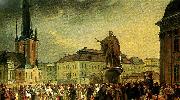 |
j. g. sandberg
|
|
Johan Gustaf Sandberg, född 1782, död 1854, var målare; han var professor i teckning vid Konstakademien från 1828, och direktör där 1845?C1853.
Sandberg ägnade sig främst åt historiemåleri, med motiv ur nordisk mytologi och svensk historia. Hans främsta verk inom detta område är kalkmålningarna över Gustav Vasa i Uppsala domkyrka. Han målade också en mängd porträtt.
Efter akademiska studier i Åbo med början 1783, och Uppsala, dit han flyttade 1788, blev han filosofie magister 1791. Han blev 1792 extra ordinarie kanslist i akademiska kansliet. Juris utriusque kandidat blev han 1792 och kort därefter docent vid juridiska fakulteten, blev juris licentiat 1800 och utnämndes 1807 till jurisprudentiä, oeconomiæ et commerciorum professor i Uppsala. Juris utriusque doktor 1810; arbetande ledamot i Lagkommissionen 1811-1814; ledamot av Krigsvetenskapsakademien 1810, Lantbruksakademien 1812, Vetenskapssocieteten i Uppsala 1829 samt flera andra lärda samfund. År 1834 erhöll han adlig värdighet och tog avsked från sin professur 1837. Lars Rabenius ligger begravd på Uppsala gamla kyrkogård.
|
|
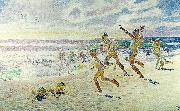 |
j. f. willumsen
|
|
(7. september 1863 i København - 4. april 1958 i Cannes) var en af pionererne bag det moderne gennembrud i dansk billedkunst omkring 1900. Han var primært maler, men mestrede de fleste kunstarter og arbejdede desuden som billedhugger, grafiker, keramiker, arkitekt og fotograf.
J.F. Willumsen studerede ved Det Kongelige Danske Kunstakademi fra 1881 til 1885. Efter tre forgæves forsøg på at blive indstillet til afgangsprøven på Kunstakademiet, studerede han på Kunstnernes Frie Studieskoler i København. I 1891 var han med til at stifte Den Frie Udstilling, hvis udstillingsbygning han tegnede i 1898.
Willumsen opholdt sig i hovedparten af sit liv uden for Danmarks grænser, hovedsageligt i Frankrig, hvor han under et ophold i Paris 1890-94 blev præget af symbolismen. I de følgende årtier blev han eksponent for flere af epokens kunstretninger og hans stil ændredes i mere ekspressiv retning.
Willumsen tilbød en stor del af sine værker og kunstsamling til staten og arbejdede fra 1930'erne på oprettelse af et museum. I 1957, året før hans død, åbnede J.F. Willumsens museum i Frederikssund.
|
|
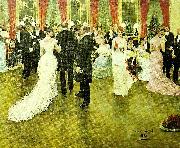 |
j. beraud
|
|
1849-1935
1849 - Saint Petersburg, Russia - 1935 Paris)
Scenes of daily life painted by Jean Beraud reveal interest in Naturalism. Such diverse themes as crowds observing the funeral of Victor Hugo (see Carnavalet, Paris) or studies of the interior of a Parisian Bank Apartment reflect aspects of French society during the Third Republic.
|
|
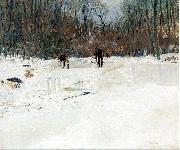 |
J. Alden Weir
|
|
(August 30, 1852 - December 8, 1919) was an American impressionist painter and member of the Cos Cob Art Colony near Greenwich, Connecticut. Weir was also one of the founding members of "The Ten", a loosely-allied group of American artists dissatisfied with professional art organizations, who banded together in 1898 to exhibit their works as a stylistically unified group.
|
|
|
|
|
|
|
|
|
|
|
| Wholesale China Oil Painting Wholesale Oil Painting China Xiamen Portrait Reproduction on canvas Chinese Oil Painting Wholesale USA Oil Painting |
|
|
|
|
|